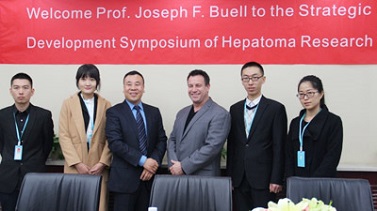In-Depth Interview with Distinguished Member of the Korean Academy of Science and Technology: Prof. Jeong Min Lee
The 2025 CACA Holistic Integrative Conference on Liver Cancer was successfully held in Hangzhou from June 13 to 15, convening leading experts to explore core strategies for the early detection and treatment of liver cancer. Through cutting-edge keynote speeches, multidisciplinary roundtable discussions, and collaborative forums, the event highlighted the latest advancements in precision medicine and promoted innovative, integrated approaches to clinical liver cancer care.
At the forum, Prof. Jeong Min Lee - Distinguished Member of the Korean Academy of Science and Technology and Professor of Radiology at Seoul National University Hospital - delivered a highly anticipated keynote lecture titled “Imaging Biomarkers for Predicting HCC Outcomes: Beyond Anatomical Assessment.” In his presentation, Prof. Lee highlighted the evolving role of imaging biomarkers in hepatocellular carcinoma (HCC) prognosis, emphasizing the clinical value of advanced imaging techniques and the integration of artificial intelligence in improving diagnostic precision and guiding individualized treatment strategies.


Image: Prof. Jeong Min Lee at the 2025 CACA International Forum on Integrated Management of Liver Cancer, Hangzhou, China
During the conference, Hepatoma Research was honored to conduct an in-depth and engaging interview with Prof. Jeong Min Lee on the theme “Advancing Prognostic Imaging and Individualized Treatment for HCC.” In this exclusive conversation, he shared his insights on the current landscape and future prospects of imaging biomarkers, AI-assisted diagnostics, and image-guided interventional therapies in improving outcomes for liver cancer patients.
Offering a forward-looking perspective on imaging-driven precision care, Prof. Lee discussed the prognostic power of enhancement patterns in HCC, the evolving utility of LI-RADS in radiation-based therapies, and the complementary roles of CT and MRI in diagnosis and follow-up. He also emphasized the importance of improving interobserver consistency and integrating tumor markers to enhance treatment response assessment.
As a pioneer in minimally invasive strategies, Prof. Lee introduced the twin-cooled RFA for treating recurrent HCC and underscored the transformative potential of AI and radiomics in reshaping personalized treatment. Bridging innovation, clinical evidence, and unmet needs, he envisions a future where imaging, biomarkers, and intelligent tools coalesce to drive more effective and tailored liver cancer care.
Interview questions:
1. At this conference, you mentioned the significant potential of imaging biomarkers in accurately predicting the prognosis of hepatocellular carcinoma. Based on your recent studies, which imaging features—such as enhancement patterns, tumor margin characteristics, or dynamic signal changes—do you consider to have the greatest clinical value in guiding prognosis assessment?
2. In your recent publication, “Temporal Evolution of the LI-RADS Radiation Treatment Response Assessment,” you explored the temporal changes in multiphasic CT/MRI after SIRT in HCC patients. How do you evaluate the strengths and limitations of LI-RADS as a prognostic imaging biomarker?
3. In your recent study comparing gadoxetic acid-enhanced MRI and contrast-enhanced CT for the noninvasive diagnosis of HCC, do you typically combine these two imaging modalities in clinical practice to optimize diagnostic accuracy? Under what circumstances do you find MRI particularly advantageous?
4. In your prospective study on enhanced radiofrequency ablation, you used the twin internally cooled-perfusion electrode technique to treat recurrent HCC after TACE. Compared with conventional RFA, what are the key advantages of this technique in controlling tumor recurrence? Are there plans to incorporate it into clinical guidelines or conduct larger-scale studies?
5. Based on your in-depth understanding of imaging and treatment response, how do you foresee the role of imaging technologies evolving in the context of individualized treatment strategies for HCC? For example, is it possible to use preoperative imaging to predict which patients are better suited for RFA versus SIRT or TACE?
6. Have artificial intelligence and radiomics already been incorporated into your exploration of imaging biomarkers? Hepatoma Research is closely following developments in this area—do you plan to incorporate AI or big data analysis into your future research projects?
Brief Introduction

Prof. Jeong Min Lee, MD, PhD, is an internationally recognized expert in liver imaging and hepatocellular carcinoma (HCC). He is a Professor in the Department of Radiology at Seoul National University Hospital and one of the most cited researchers in the field of abdominal imaging. Prof. Lee received his MD and PhD from Seoul National University and has led groundbreaking research at the intersection of diagnostic radiology, oncologic imaging, and individualized treatment strategies for liver disease.
Prof. Lee has authored over 500 scientific articles in leading international journals and is a Fellow of both the European Society of Gastrointestinal and Abdominal Radiology (ESGAR) and the International Society for Magnetic Resonance in Medicine (ISMRM). His work has significantly advanced the noninvasive diagnosis and prognostic assessment of HCC, particularly through innovations in gadoxetic acid-enhanced MRI and LI-RADS-based imaging biomarkers.
In 2025, Prof. Lee delivered a landmark keynote address at the Chinese Anti-Cancer Association (CACA) Liver Cancer Summit, sharing his vision for precision imaging and interdisciplinary collaboration in liver cancer management.
Selected Honors and Awards
- Fellow, European Society of Gastrointestinal and Abdominal Radiology (ESGAR)
- Fellow, International Society for Magnetic Resonance in Medicine (ISMRM)
- Author of over 500 peer-reviewed publications
- Regular invited speaker at international radiology and liver cancer conferences
- Top-ranked expert in hepatocellular carcinoma imaging (based on citations and impact)
Prof. Lee continues to push the boundaries of imaging-based precision medicine. His recent studies focus on evaluating treatment response after locoregional therapies, leveraging AI-assisted image analysis, and refining diagnostic algorithms for liver malignancies. His contributions are redefining the role of radiology in oncology — making it more predictive, personalized, and impactful.
Stay tuned with Hepatoma Research for more exclusive interviews with global leaders advancing liver cancer research and precision oncology.
Managing Editor: Victoria Lee
Language Editor: Catherine Yang
Production Editor: Ting Xu
Respectfully submitted by the Editorial Office of Hepatoma Research










